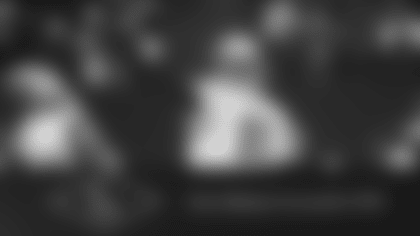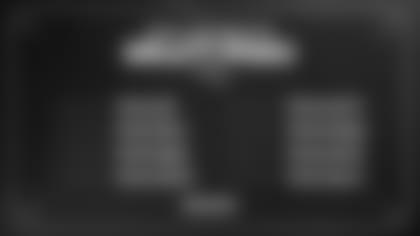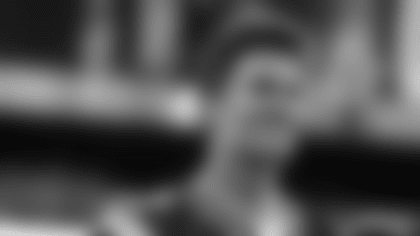New England Patriots head coach Bill Belichick addresses the media during his pre-draft press conference at Gillette Stadium on Wednesday, April 16, 2008.
BB: We're plugging along here. There are still a lot of loose ends to tie up, but that's kind of the way it usually is this time of year. Got the few last visits coming in this week and then next week's the time where we talk a little bit of draft strategy and try to finalize some of the grades, make some comparisons of situations that might present themselves, re-evaluate the trade charts and stuff like that. I think the process is going along about like it normally does. It was a late start, but that's when you want to start. So I think Scott [Pioli] and Nick Caserio and the rest of the scouting department have done a good job of researching, accessing a lot of information. We've had a lot of scouts out on the road. We've seen a lot of people. Hopefully, we'll be in a position to make some good decisions and try to improve our football team next week.
Q: How much would you say the changes in the timing now, the 10 minutes in the first round, and having to have all the details straight with the league office. Is that going to really impact, or be a big change for draft rooms for all you folks?
BB: It might be. I think it'll be interesting to see how that goes. I think the five-minute timing in rounds three through seven, it usually isn't too much of a problem because most of those trades are pretty straightforward. If you move up in the fourth, you give them your fifth round pick and that type of thing. It's pretty straightforward. I think in some of the more complex trades that we've been involved with, even last year with the San Francisco trade in the first round, there's a little more negotiating. There's a little more back and forth on a trade in that round than there is in the later rounds. So you can say, 'Yeah, we're used to dealing with the 10-minute time frame like we used to be in the second round.' But I think those first-round trades sometimes are… there's a little more degree of difficulty in the small moving parts than what there is in some trades in the later rounds. We'll see how that goes. I think, probably, and we do this anyway so it's not any big departure procedure, but you try to talk to the teams that you might be considering that are sort of in your neighborhood that you might be considering working with just to get some ideas of a parameter or who might be interested so you don't waste time. That 10 minutes, I know when you're waiting for somebody else to pick, it seems like it's a long time. You're sitting there and you guys watch that 10 minutes go by and it seems like a half hour. And that's what it seems like for us when somebody else is on the clock. When it's your pick and you're on the clock, those 10 minutes seems like about 45 seconds sometimes. Being prepared for that, it'll be interesting to see how that goes. I don't think the second round, I don't think that will have that much of an impact. The first round, if you're involved in a trade, you're going to have to get it done.
Q: You mentioned the trade chart. There's been a version of that online that's been passed around over the years and now there's a new one. Has there been an adjustment in the value of those picks at the top of the draft?
BB: First of all, I think every team has their own trade charts. I don't think there's any one where everybody uses the same chart, although I think there is some benefit to at least knowing what some other charts are, what some other values are. You know what somebody else is looking at. That doesn't mean you accept it, but at least you know when you're dealing with somebody else what they may be thinking or what they might be looking at. I think that's something you look at every year and that's what we do. That's part of our annual draft review and that's something more that we'd look at next week, but you look at all of the trades that were made in the previous year's draft and you look and say, 'This trade, this team gave up a little bit more than we would want to give up in that situation. This team gave up a little less and that was a good trade.' But again, ultimately, it's just comes down to a little bit of how much you want to trade the pick. If you really want to trade it, then you'll take less. If you really don't want to trade it, then it might take more to get you to give it up. Some of that's a function of how willing, I should say the seller in this case, how willing the seller is to trade and, conversely, how anxious the buyer is to buy. If they really want that pick, then they're willing to give up more. Maybe even more than it might be worth on a so-called chart, but based on the value of the player and what they think that player will bring to their franchise, then they're willing to pay a little bit more. I think there's a general range, or value, but within that each situation is a little bit different. We'll review it this year like we always do.
Q: How much do you model the situations that can occur in the draft beforehand?
BB: Model them?
Q: Maybe going through a mock draft yourself.
BB: We talk more about the value of the players than trying to get it right. It's one thing when you have three of four players at the same position and say, 'Well, which one? What order will we take them in?' It's a lot different when you're comparing a player in one position to another player in another position on the other side of the ball. Who has more value? Who's better now? Who's going to be better in two years? Then you get into all of the other stuff - injury and production and so forth and so on. You're never really comparing apples to apples. Very seldom are you comparing, sitting there talking about two receivers. It's usually a player at one position, a player at another position, often on the other side of the ball. Maybe special teams will come into play with one player and it really doesn't with another. So you try to go through some of those scenarios ahead of time of trying to make sure you have those players graded if you had to take them the way you would want them, or if it came down to a choice between one of two or three guys how you would order those. It's a hard exercise. It really is because there, like I said, it's not apples to apples. You're looking at a lot of different things so that's the kind of thing we do.
Q: You talk about the value of a position in a draft and the value of a player when you get to your position. Is that value in general with players left on the board or the value of a position that you need? For instance, for the sake of argument, if Matt Ryan was the top player that slipped to No. 7 was the top player on the board left and - me, personally, I can't see you taking a quarterback-would that cause you to go in a different direction?
BB: I think the quarterback is kind of an exception to the rest of the question if I could say that. I think you look at the teams that have done that, that have a starting quarterback at that level and then drafted another one in the first round, eventually something has to give. You look at San Diego, for example, when they drafted [Philip] Rivers and they had Drew Brees. It's just kind of prohibitive to pay two starting quarterbacks. Now, if it's any other position, you probably can… it's a little bit easier to work around. I'm not saying it's ideal, but you could probably have two starting, two top-level receivers, or two top-level linemen, or two top-level whatever. I would say the quarterback is a little bit tougher. Outside of that, it really does come back down to value and just because you need a position or maybe you'd like to have a certain position and then you take the player at that position and you put his name up there on the board, once you get out there in August, or more importantly, in November and that player can't actually perform that job or that position and play it the way you need it played then you haven't really accomplished much. That fill-in needs and draft grades the day after the draft doesn't really mean anything. What really means something is a year or two down the road whether the player you've taken can do what you selected them to do, and if he can then that's a good pick and if he can't then it really isn't. What we want to try to make sure is that we get the most value for our pick and that's a very inexact science. Sometimes you're right and sometimes you're wrong.
Q: How does this linebacker class, especially for 3-4 teams specifically, look compared to say the last couple of years?
BB: I think it's about the same.
Q: How about corner? How would you assess the corner class this year?
BB: Probably more names and a little more depth. Whether that translates into more players or not, I don't know. There will probably be more guys drafted. Whether they're able to perform to an NFL level, we'll see.
Q: Friday's the deadline for restricted free agents if teams want to make an offer sheet. Do the Patriots have any plans to do that or is that still under consideration?
BB: Yeah, it's still a possibility. Right. That would have to be done by Friday. We've got a couple more days. Part of that's a function of if we were picking in X-round would we rather have X-player as a restricted player? That's if you could get him. Then whether you would get him or not would depend on whether the team you offered matched it. So even if you did it, there's still no assurance you would get him, but kind of the discussion would be, 'If we had this player, gave him X-contract, would we rather do that than to pick from this other group of players in that round?' Whatever that happens to be. That's the kind of decision you would be making.
Q: You've been bringing in an awful lot of players and we sit and look at the names and the positions and we think we're going to get an idea of where you're going, but how much of that is really genuine interest versus a little bit of gamesmanship on your part? Because everybody's trying to figure out who you'll be picking if they have interest in a certain player. Everybody does it. So how much is actually fact finding as opposed to throwing other people off your scent?
BB: I don't know. 85-15? 90-10? I don't know. I'm sure there's an element of that, but you know the two main reasons for bringing a player in are: No. 1, for a physical examination and No. 2 just to spend more time with the player and that's sometimes based on … We've had a number of players in from the West Coast. We usually always do that. It's hard to get to all the players on the West Coast for us, between myself and Scott Pioli and Nick [Caserio] and the scouts that scout out there. It's easier to hit some of the other places around here, one way or another, than it is to get out there. So that'll be a reason to spend time with somebody that you really haven't had a chance, or maybe at the Combine, you didn't get a chance to spend time with, or the Senior Bowl - we weren't at the Senior Bowl this year, the scouts were but the coaches weren't. It's just there's no set formula for it. It just players that you either want to spend more time with or that you want to have a physical exam with your doctors and we have the Indianapolis exams and then the re-check physicals, but sometimes there are other things that our doctors will say, 'We recommend you bring this particular player in so that we can do X, Y exam that we weren't able to do in Indianapolis.' OK. And if we're seriously considering that player, that's something that we want to do ahead of time rather than draft him and get him in and then find out there's a problem that we didn't know about. Again, I wouldn't… there are players that we feel we know pretty well and we've got a lot of information on them, it's all consistent and there isn't really a need to bring that player in so it doesn't mean we're not interested in that player. It just means we don't feel like we need to bring him in.
Q: Logan Mankins was a guy that you didn't talk to before the draft.
BB: Yeah, I don't think Logan visited here, but James Sanders did, I believe. A lot of times with the younger players coming out, like James [Sanders], who came out as a junior, that's another thing. The scouts can't really go in and scout them. They can watch them on film, but the college coaches, you can't talk to them until they're clear for the draft and they're not usually in the bowl games, like the Senior Bowl or the Hula Bowl and stuff like that so your only chance is at the Combine and sometimes that's a short interview if you don't get enough time with a player there then maybe you set something up. A lot of the interviews are with players like that, guys that have declared early that you just don't have as much background or haven't spent as much time with the player.
Q: It seems like a general perception that teams are trying to trade out of the top of the draft. Is it too early to gauge that, or is that a case of the crop that's there? The money?
BB: I think money's a little bit of an issue. You're paying a lot for those players. If you don't think the value is there then that might be a reason to try to trade out, but I think this is a draft where there doesn't appear to be a clear-cut No. 1 player. I'm sure if you, or somebody in the media, which I know they have, contacted teams anonymously about who they're top players are there would be some discrepancies as to who the No. 1 player is. To me, it's a little bit like the '91 Draft when I was in Cleveland and, actually, the Patriots traded out of that to Dallas. Dallas traded up and the first few picks there were, I don't think there was any consensus on the order of those players and Russell Maryland was a little bit of a surprise choice at No. 1. Again, that was a draft that, as it turned out, there were a lot of players in the second round, the Brett Favres, the Roman Phifers, the Phil Hansens and guys like that than probably had better careers than a lot of guys in the first round of that draft. In fact, there was probably about a third of that first round that I don't know if they lasted three years in the league. I just think it's not clear-cut as to whom those players are. If you know so and so is going to be the second or third pick then you've got to get to that certain spot to get him then that's one thing. If there's a player you like and there's no real consensus that he'll be the second or third player picked then maybe he'll make it to you at five, or eight, or 10, or wherever you're sitting. When you trade in the first round, you're really trading for a player. You're not really trading picks. You're trading for a specific guy and a lot of times it's pretty obvious who you're trading for too. You know it. They know it and so does everybody else who's watching.
Q: At this point in your career, you've got a pretty extensive coaching tree down to the college ranks. Do you reach out to a lot of those guys to maybe get information on players that maybe you can't get on film?
BB: We try to talk to all the people that we have relationships with. Coaches that you have coached with or even coaches that you haven't that you have a relationship with through the years. On the other hand, they have relationships with a lot of other coaches, too. It's not unique. We talk to the people that we know and we do the best research we can on the players and so does everybody else. In the end, those coaches are responsible to help their players. They recruited them. Those guys played for them and they want to help them in any way they can help them whether that's with the Patriots or one of the other 31 teams and we understand that and we respect that they can't just work for one team. They have a responsibility to their college and their player that played for them for their college career.
Q: You talked earlier about the money that's devoted to a top pick. When you're picking that high, does the balance shift at all to they need to produce sooner because of the money that's being given to them?
BB: I don't know. I think every team takes the player that they think is best for their organization. You have to balance a lot of things.
Q: How comfortable are you with working out of where you are and having the No. 7 pick?
BB: Well, we haven't been at that position for a while. We picked sixth in 2001, but it's a lot easier looking at the top third of the players in that round than trying to sit back in the late 20s and try to figure out what's going to be there when you pick. You're dealing with a lot less players. Between our first and second pick is, whatever it is, 50-something spots. There are going to be a lot of players that if we don't take them at seven, they're not going to be there when we pick in the second round. We know a lot of those guys will go by the boards so it's a pretty big drop off from our first pick to our second pick in terms of the players that we're evaluating. There are a lot of guys in there that we realistically won't have a shot at. No different than if you're picking in the 20s, there are guys in the top 10 or 15 that you're not going to have a shot at either.
Q: Are you in favor of a rookie salary cap? I know it's been kind of tossed around a little bit, but is that something that…
BB: Well, there is one. There's a rookie pool. All I'm saying is that the top slots in the draft, those are big contracts. I mean, the first-rounders are going to make more than the second-rounders and the second-rounders are going to make more than the third-rounders. We all understand that, but those top few picks - JaMarcus Russell's contract and contracts like that - those are big contracts.
Q: Do you think those should be capped?
BB: Whatever the league and the players agree to, that's what it's going to be. It doesn't make a difference what I think.
Q: With the schedule coming out yesterday, obviously you already knew you had four trips to the West Coast, but given the fact that there are two sets of back-to-back, might there be any consideration of possibly staying out there for one or both of those trips?
BB: Yeah, we've talked about that and that's something we'll look into. I think that's certainly a consideration and one's early, one's later. We'll have to see what the options are on that, but that would be a consideration.
Q: We sit here 10 days before the draft. In your mind, are there two or three players you know you're zeroing in on that you can say right now? By the way, feel free to tell us who they are if you want.
BB: Oh, OK. Well I want to get to that. I want to get to that. Yeah, obviously we're picking seven so it's … I think we can narrow it down to a fairly small number of players and if those players, those are the players we're considering. I'm not going to sit here and tell you we're thinking about one of 20 guys. We've got a handful of guys that we're considering and maybe they'll be there. Maybe one of them will be there. We'll just have to wait and see how that goes and that might affect our strategy at that time when we pick, but yeah, we've got it narrowed down to a much smaller target than we had two weeks ago or two months ago.
Q: How much of your strategy is affected by the fact that by having that wide gap between the first and the second pick?
BB: Not much because there's really … We can't go too far down from seven and you can't go too far up from 62 or whatever it is. So how far can you go? We're not going to go from 62 to 15. There's a little bit of play there, but I think you really talking about the same group of players.
Q: In your time here, the highest you've taken a linebacker is in the fifth round and you've talked in the past about evaluating your standards and saying your standards are too high. Have you re-evaluated those standards?
BB: We'll do what's best for our football team. That's what I've done since I've been here and that's what we'll do going forward.
Q: On Brandon Meriweather, you started out using him more at corner and then more so at safety. Does that at all affect your draft strategy going in?
BB: It doesn't affect our draft strategy, no. Whoever we have on our team, we have. Whoever's in the draft is in the draft. We'll take the players that best suit our team from the draft and that's it. Brandon is a versatile player and I'm sure he'll have a variety of jobs going forward. How that plays out, we'll wait and see on that when we get to the spring camps and training camp. But he's a good player and he'll help our football team and hopefully we'll draft somebody that will also be able to help our football team. That's our goal.
Q: There's a couple of defensive tackles in the draft and are you considering drafting one who will push Vince Wilfork? [After Wilfork had entered the room]
BB: That's something we're looking very closely at. Very closely. [Laughter].









































